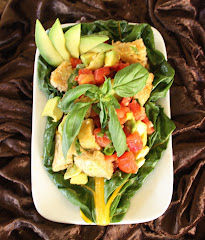
DAZZLING ARRAY OF FRUIT AND VEGETABLES

I had to do a lot of shopping for this week and I was so looking forward to my visit to the farmer's market this morning. I really was looking forward to shopping and seeing what I was going to find. I was not only delighted but surprised at the wide variety I was able to get today. I really like that I am committed to my Saturday journey to the market, because I discover such amazing things each week. I learn something new and I try to go in without expectation and that makes it so much fun!
I decided to do a photo shoot of the wide variety of produce I got today. I got ever ything from Rambutan (red furry outside and white chewy inside), Tahitian passion fruit (bright orange outside, edible inside), Star Apple Fruit (inside looks like a st
ything from Rambutan (red furry outside and white chewy inside), Tahitian passion fruit (bright orange outside, edible inside), Star Apple Fruit (inside looks like a st ar), guava, Dinosaur Kale (exterior looks ancient), organic papaya, juicy tomatoes, local strawberries, huge avocadoes, Japanese cucumbers, fresh white corn, sweet Maui Onions, apple bananas and Thai Basil, Sweet Basil and young ginger.
ar), guava, Dinosaur Kale (exterior looks ancient), organic papaya, juicy tomatoes, local strawberries, huge avocadoes, Japanese cucumbers, fresh white corn, sweet Maui Onions, apple bananas and Thai Basil, Sweet Basil and young ginger.
 ything from Rambutan (red furry outside and white chewy inside), Tahitian passion fruit (bright orange outside, edible inside), Star Apple Fruit (inside looks like a st
ything from Rambutan (red furry outside and white chewy inside), Tahitian passion fruit (bright orange outside, edible inside), Star Apple Fruit (inside looks like a st ar), guava, Dinosaur Kale (exterior looks ancient), organic papaya, juicy tomatoes, local strawberries, huge avocadoes, Japanese cucumbers, fresh white corn, sweet Maui Onions, apple bananas and Thai Basil, Sweet Basil and young ginger.
ar), guava, Dinosaur Kale (exterior looks ancient), organic papaya, juicy tomatoes, local strawberries, huge avocadoes, Japanese cucumbers, fresh white corn, sweet Maui Onions, apple bananas and Thai Basil, Sweet Basil and young ginger.
I was like a kid in a candy store. I had SOOOOO much fun. I had as much fun returning from my shopp ing spree and looking at my loot. I had to take photos of this amazing display. I feel so abundant and grateful to have access to such incredible fresh produce.
ing spree and looking at my loot. I had to take photos of this amazing display. I feel so abundant and grateful to have access to such incredible fresh produce.
 ing spree and looking at my loot. I had to take photos of this amazing display. I feel so abundant and grateful to have access to such incredible fresh produce.
ing spree and looking at my loot. I had to take photos of this amazing display. I feel so abundant and grateful to have access to such incredible fresh produce. What I know for sure is that my creativity increases when I see what nature has produced. It's amazing that there is such a vastness in the world we live in. I love the fact that the colors of nature are so vibrant and make me feel alive. Yes, I feel more alive with fruits and vegetables in my life! And I feel grateful for the farmer's and sellers that are dedicated and show up each week to provide us with their labor of love.
Now I get to delve into this amazing selection and create dishes that are bold, unique, colorful and freshness oozes from each bite.
Always Fresh, Always Delicious, Always with Aloha...




































